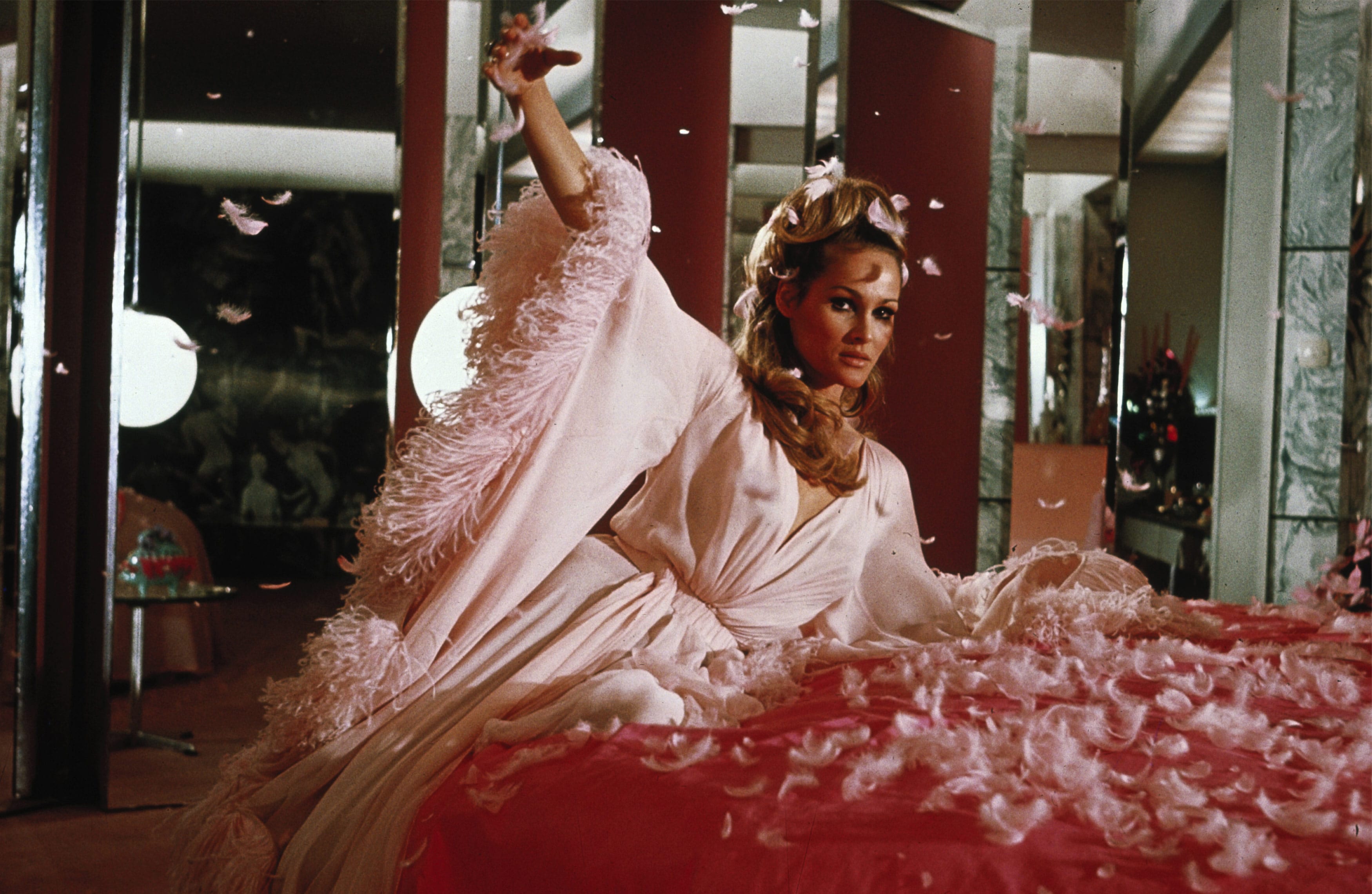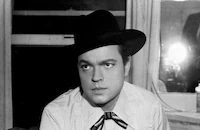Casino Royale

Brief Synopsis
Cast & Crew
John Huston
David Niven
Peter Sellers
Ursula Andress
Orson Welles
Joanna Pettet
Film Details
Technical Specs

Synopsis
The original James Bond (007) retired following his star-crossed love affair with Mata Hari and watched with disdain as his gimmick-laden imitators sullied his name. But as the international crime organization known as SMERSH threatens world domination, he agrees to come out of retirement. After his longtime superior McTarry ("M") is killed, Bond goes to Scotland to console McTarry's widow, Lady Fiona, unaware that the woman he encounters is actually a SMERSH agent. Bond's charms are such, however, that Lady Fiona gives up her life of espionage and retires to a convent when Bond declines her offer of love. To outwit his enemy, Bond decides there should be more than one 007 agent. He enlists the services of Vesper Lynd, the world's richest and most seductive spy; Evelyn Tremble, the inventor of a foolproof gambling system; Cooper, a strong-arm agent trained to resist women; and Bond's own daughter, Mata Bond. While Mata is outwitting SMERSH in Berlin, Bond sends Tremble and Vesper to the famed Casino Royale, and there SMERSH agent Le Chiffre is attempting to replenish his organization's finances by playing baccarat. Although Tremble defeats Le Chiffre at the gaming tables, Vesper is kidnaped as they leave. In pursuit, Tremble is captured, tortured, and eventually shot. Mata is also abducted and carried off in a flying saucer. SMERSH begins to get the upper hand, and Bond swings into action. Upon learning that the casino is merely a front and that SMERSH is headed by his own fiendish nephew, Jimmy Bond, Sir James utilizes the charms of The Detainer (another 007) to induce Jimmy to swallow an explosive capsule. Bond then calls for his allies--the French Foreign Legion, tribes of American Indians, the U. S. Cavalry, United Nations paratroopers, and the Keystone Cops--to invade the casino. During the ensuing melee, Bond makes a strategic exit as Jimmy's internal bomb goes off and the casino and its occupants are blown up.

Directors

John Huston
Ken Hughes
Val Guest

Robert Parrish
Joseph Mcgrath
Cast

David Niven

Peter Sellers

Ursula Andress

Orson Welles

Joanna Pettet
Daliah Lavi

Woody Allen
Terence Cooper
Barbara Bouchet

Deborah Kerr

William Holden

Charles Boyer

John Huston

Kurt Kasznar

George Raft

Jean-paul Belmondo

Peter O'toole
Angela Scoular
Gabriella Licudi
Tracey Crisp
Elaine Taylor

Jacqueline Bisset
Alexandra Bastedo
Anna Quayle
Stirling Moss
Derek Nimmo
Ronnie Corbett
Colin Gordon
Bernard Cribbins
Tracy Reed
John Bluthal
Geoffrey Bayldon
John Wells
Duncan Macrae
Graham Stark
Chic Murray
Jonathan Routh

Richard Wattis
Vladek Sheybal
Percy Herbert
Penny Riley
Jeanne Roland
Arthur Mullard
Crew
Burt Bacharach
Burt Bacharach
Roy Baird
Ivor Beddoes
Bermans Of London
Les Bowie
Jerry Bresler
Lionel Couch
John Dark
Hal David
Charles K. Feldman
Charles K. Feldman
Sash Fisher
Chris Greenham
Val Guest
Val Guest
Julie Harris
Ben Hecht
Joseph Heller
Jack Hildyard
John Howell
John Huston
Bob Jones
Dick Langford
John Law
Tutte Lemkow
Bill Lenny
Wolf Mankowitz
Carl Mannin
Barrie Melrose
John Merriman
John W. Mitchell
Terence Morgan Ii
John O'gorman
Douglas Peirce
Cliff Richardson
Nicolas Roeg
Michael Sayers
Joan Smallwood
Neville Smallwood
Terry Southern
Anthony Squire
John Stoneman
Michael Stringer
Richard Talmadge
Roy Whybrow
John Wilcox
Billy Wilder
Richard Williams
Richard Williams

Videos
Movie Clip




Trailer
Film Details
Technical Specs

Award Nominations
Best Song
Articles
Casino Royale
On the screen, Casino Royale looks like one big swinging party, but it was an entirely different story behind the scenes. The trouble started when producer Feldman found out after he bought the rights to the book that all he really owned was the title. According to co-director Val Guest in Woody: Movies from Manhattan by Julian Fox, "the rival Bond producers, Salzman and Broccoli, had already used everything in the book except the baccarat game, so the whole thing had to be structured around that." Sean Connery and Shirley MacLaine were first considered for starring roles while Bryan Forbes and Clive Donner were both in the running to helm the project. None of this panned out so Feldman decided to hire several directors for the project (John Huston was among them) with David Niven (Ian Fleming's original choice for the 007 role) playing the role of Sir James Bond. The basic plot has Bond being recalled to active duty in Scotland where he encounters the widow of a colleague (Deborah Kerr) now working for the evil SMERSH empire. The British Secret Service decides to confuse their enemy by creating a number of Bond decoys, one of whom is a cardshark (Peter Sellers) who takes on the villainous Le Chiffre (Orson Welles) in a marathon baccarat game.
Feldman was particularly excited about the casting coup of Peter Sellers in the role of Evelyn Tremble, even though he had been warned against hiring him by several industry insiders who knew the actor could be extremely tempermental. Sellers, who was at the height of his career thanks to the critically acclaimed Dr. Strangelove (1964) and the box-office successes of The Pink Panther (1964), A Shot in the Dark (1964) and What's New, Pussycat? (1965), turned out to be a total nightmare on the set. Despite a recent heart attack, he insisted on subjecting himself to a rigorous course of body-building exercises and running; he even devised a special catlike walk for his character. But his professional dedication soon gave way to unpredictable mood swings and violent tantrums; he fought constantly with director Joe McGrath (a personal friend he insisted be hired for the film) and, at one point, their anger erupted into a slugging match.
Sellers' superstitious nature also dictated his decisions; he demanded that an enormously expensive set be destroyed prior to its use because he had a nightmare about it in which his mother said she didn't like it. Worst of all, he developed an irrational fear about his co-star Orson Welles and refused to appear in scenes with him. In Peter Sellers: The Authorized Biography by Alexander Walker, Joe McGrath said, "This was my first film in Panavision, the letter-box-shaped screen. You could hold a hundred yards of the set in the lens. We had seven hundred extras for the gaming tables sequences, but we had no way of bringing our two stars together in the same shot!." But the problems persisted - including Sellers' three-week disappearance while 2,000 extras waited - until the actor suddenly quit, throwing Feldman into a panic. At first, there were rumors that drag star Danny La Rue was being brought in as Sellers' replacement. Instead, Feldman flooded the film with a multitude of faux-Bond characters in an effort to lessen Sellers' importance in the plot. Joanna Pettit's role as Mata Hara was also built up and so was Woody Allen's as Jimmy Bond/Dr. Noah.
But for Woody Allen, Casino Royale was simply a job with an attractive salary. He would spend his time off the set playing high-stakes poker, using his winnings to buy German Expressionist art (an Emil Nolde watercolor, a drawing by Oska Kokoschka) or purchase hard-to-find jazz records for his personal collection. In Woody Allen: A Biography by Eric Lax, the actor/writer/director confessed (in a letter to a friend) that Casino Royale "is a madhouse. I haven't begun filming yet but saw the sets for my scenes. They are the height of bad pop art expensive vulgarity. Saw rushes and am dubious to put it mildly, but probably film will coin a mint. (Not money, just a single peppermint.) I play the villain (okay to give that out) and also James Bond's bastard nephew (not all right to give that out) and my part changes every day as new stars fall in....I would like it emphasized and made quite clear that I am not a writer of Casino. I'm adding a few ad-lib jokes to my own part but that's all. In fact...we demanded a letter saying my name cannot appear on screen as writer. This because everyone who contributed a comma is demanding his name on the film and the writers' list looks like Terry Southern, Ben Hecht, Michael Sayers, Frank Buxton, Mickey Rose, Peter Sellers, Val Guest, Wolf Mankowitz, etc."
By the end, the budget of Casino Royale had swollen from its initial cost of $12 million to more than twice that amount. And no wonder the costs were high considering the extensive locations included Paris, the South of France, West Berlin, Ireland, and the Pinewood and MGM-British studios in England. The mammoth slapstick climax alone - featuring Jean-Paul Belmondo as a French Legionnaire, George Raft as himself, and countless famous faces - cost $1 million and took two months to shoot! Yet, despite the film's troubled production history, there is fun to be had amid the insanity - everything from Scottish comedian Ronnie Corbett as a robot with a German accent to the lovely Jacqueline Bisset as Miss Goodthighs. So, if you want to experience the sixties - Hollywood-style - this is the ultimate pit stop.
Producer: Jerry Bresler, John Dark, Charles K. Feldman
Director: Val Guest, Ken Hughes, John Huston, Joseph McGrath, Robert Parrish
Screenplay: Wolf Mankowitz, John Law, Michael Sayers, based on the novel by Ian Fleming
Cinematography: Jack Hildyard
Editing: Bill Lenny
Music: Burt Bacharach
Art Direction: Ivor Beddoes, Lionel Couch, John Howell
Cast: Peter Sellers (Evelyn Tremble), Ursula Andress (Vesper Lynd), David Niven (Sir James Bond), Orson Welles (Le Chiffre), Joanna Pettet (Mata Bond), Daliah Lavi (The Detainer), Woody Allen (Jimmy Bond/Dr. Noah), Deborah Kerr (Agent Mimi aka Lady Fiona McTarry), William Holden (Ransome), Kurt Kasznar (Smernov), Barbara Bouchet (Moneypenny), John Huston (McTarry), Anna Quayle (Frau Hoffner), Peter O'Toole (Piper).
C-132m. Letterboxed.
by Jeff Stafford

Casino Royale
Quotes
Are you Richard Burton?- Piper
No, I'm Peter O'Toole!- Evelyn Tremble
Then you're the greatest man that ever BREATHED.- Piper
What's the strategy, sir?- Cooper
Get out of the bloody place before it blows up!- Bond
Hmmm, it is little Otto. He was one of your mother's lovers. We often find him lying around.- Frau Hoffner
Is he dead?- Mata Bond
Hard to tell. He always looked like that.- Frau Hoffner
You can't shoot me! I have a very low threshold of death. My doctor says I can't have bullets enter my body at any time.- Jimmy Bond
I bet Mummy would've taken me in!- Mata Bond
Mummy took everyone in.- Sir James
Trivia
Cameos by Frank Sinatra, Sophia Loren, and Barbra Streisand were planned.
When Mata Bond swings into action, the background music is "Bond Street".
Peter Sellers and Orson Welles hated each other so much that the filming of the scene where both of them face each other across a gaming table actually took place on different days with a double standing in for one the actors.
Sellers often caused interruptions by leaving the set for days at a time.
Numerous screenwriters and directors contributed bits to the film and were uncredited: Billy Wilder (the "Nobody's Perfect" tag line) and Terry Southern (the war room in Berlin) among them.
Notes
Location scenes filmed in England, Ireland, and France. Released in Great Britain in 1967; running time: 131 min. Wilder, Hecht, Huston, Guest, Heller, and Southern are uncredited screenplay writers.

Miscellaneous Notes
Released in United States 1967
Released in United States Winter January 1, 1967
Released in USA on video.
Released in United States 1967
Released in United States Winter January 1, 1967














